MXA RACE TEST: THE REAL TEST OF THE 2020 HUSQVARNA FX450
Q: FIRST AND FOREMOST, WHAT MAKES THE 2020 HUSQVARNA FX450 DIFFERENT FROM THE FC450?
A: First, it’s not all that different. Except for a few obvious concessions to the cross-country worthiness of the FX450 over the motocross-specific FC450, the big difference is in the degrees of intent. The Husqvarna engineers intended the 2020 FC450 to be a motocross bike—and they pulled out all the stops to achieve that goal. That meant the powerband, suspension, accouterments and setup were designed for hammering through whoops, accelerating off the line, sailing through the air and battling bar to bar with the competition. The FX450 backed down those aspects to make it a cross-country-specific off-road bike that was easier to ride and more forgiving over rocks and roots, carried more fuel for the long haul, and was better suited to cross-country terrain.
But—and this is a big but—the 2020 FX450 is not meant to be the be-all, end-all of Husqvarna’s off-road bikes; rather, it is designed to expand the line’s breadth by bridging the gap between the FC450 motocross bike and the FE501 enduro model.
Let’s take a moment to recap. The 2020 Husqvarna FC450 is designed, built and intended to be a motocross bike; the 2020 Husqvarna FX450 offers a compromise machine that can be used for motocross (with limitations) or for off-road enduros (with limitations); the 2020 FE501 is a pure off-road enduro bike with a stroked engine, six-speed wide-ratio transmission, smaller throttle body, slightly less travel with the WP Xplor forks, a headlight/taillight combo and spark-arrestor muffler.
In short, the FC450 is a motocross bike, and the FE501 is an enduro bike; the FX450 is a compromise bike.
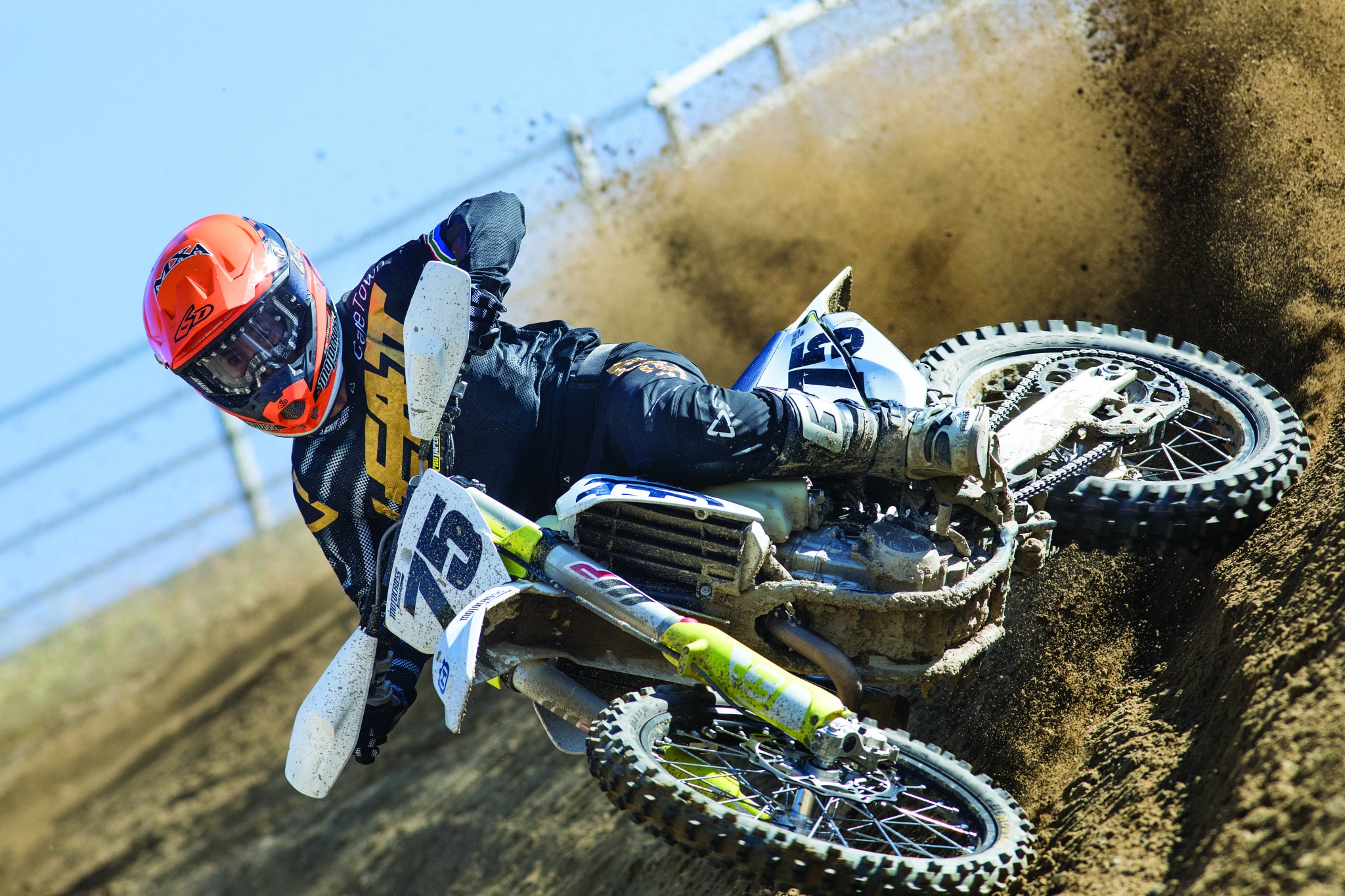 THE GEAR Jersey: Leatt GPX 5.5 Ultraweld, Pants: Leatt GPX 5.5 Ultraweld, Helmet: 6D ATR-2, Goggles: Leatt Velocity 5.5 Iriz, Boots: Gaerne SG-12.
THE GEAR Jersey: Leatt GPX 5.5 Ultraweld, Pants: Leatt GPX 5.5 Ultraweld, Helmet: 6D ATR-2, Goggles: Leatt Velocity 5.5 Iriz, Boots: Gaerne SG-12.
Q: HOW DO THE 2020 HUSQVARNA FX450, FC450 & FE501 DIFFER?
A: In truth, the FX450 shares more with the FC450 than it does with the FE. Here is a quick list of differences.
(1) Engine components. The FX and FC use the same basic engine. That means that the pistons, cams, valves, cranks, cases, 44mm throttle bodies, exhaust systems and cylinder heads are the same on both powerplants.
(2) Bore and stroke. The FX450 and FC450 get 449.9cc from 95mm by 63.4mm bores and strokes. The FE501 uses the piston from the FX and FC but has a longer 72mm stroke, which increases its displacement to 510.9cc.
(3) Transmission. Unlike on the six-speed, semi-wide-ratio Husqvarna FE501 gearbox, the motocross-ready FC450 and cross-country-focused FX450 use the exact same five-speed gearbox (and all three share the same damped diaphragm clutch, operated by a Magura master cylinder and slave unit).
(4) Electronics. The identical push-button map switch is used on the FE450, FX450 and FC450. All three offer two engine maps, traction control and launch control, although the engine mapping is different.
(5) Suspension. Unlike the FE501, which uses WP Xplor forks, the FX450 and FC450 are equipped with WP Xact air forks and Xact shocks; however, the valving on the FX450 is much more compliant, while the air pressure recommendations are lower and the rear shock spring is stiffer (45 N/mm on the FX compared to 42 N/mm on the FC450).
 The gas tank is big, but it is slim. For motocross we just filled it up halfway.
The gas tank is big, but it is slim. For motocross we just filled it up halfway.
(6) Gas tank. To make the 2020 FX450 capable of completing off-road loops and competing in longer GNCC and WORCS events, the FX gas tank holds 2.25 gallons of fuel, while the FC450 motocross tank holds 1.9 gallons. Additionally, the FX450 gas tank is translucent so that the rider can check the fuel level at a glance. The motocross tank is black.
(7) Wheels/tires. The major difference between the FX and FC is that the motocross bike runs a 19-inch rear wheel shod with a Dunlop MX3S tire, while the FX450 and FE501 have 18-inch rear wheels and Dunlop AT-81 rear tires.
(8) Miscellaneous. Unlike the FC450 motocrosser, the FX450 comes with hand guards, a kickstand, push-button gas cap, fuel warning light and non-gripper seat cover.
(9) Retail price. The 2020 Husqvarna FC450 retails for $10,099. The FX450 retails for $10,699, and the FE501 retails for $11,099.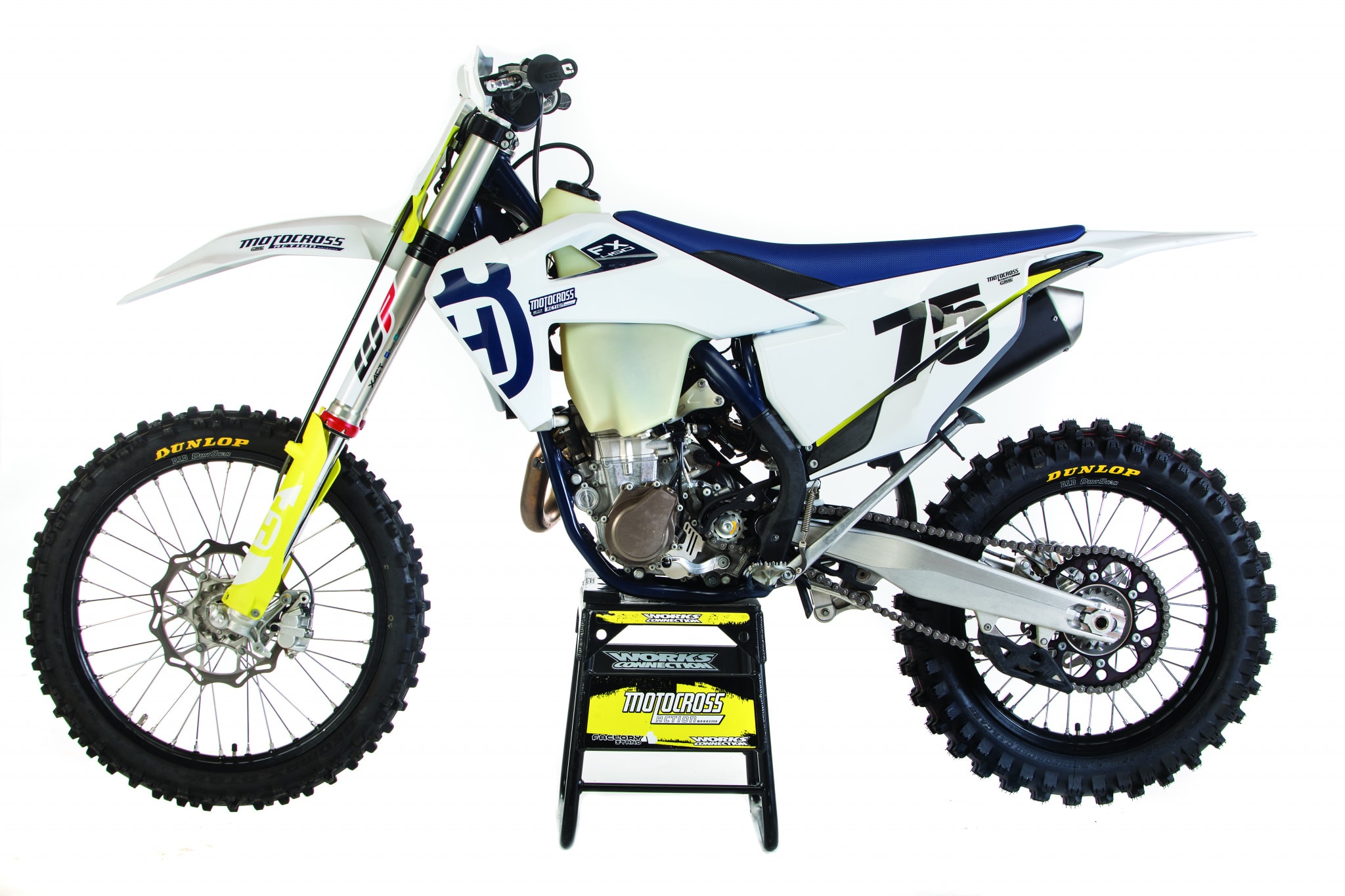 The Husqvarna FC450 isn’t made for the dedicated motocrosser or hardcore off-roader. This is the ultimate machine for the guy looking for one bike that can do more than one thing.
The Husqvarna FC450 isn’t made for the dedicated motocrosser or hardcore off-roader. This is the ultimate machine for the guy looking for one bike that can do more than one thing.
Q: WHAT ABOUT THE FX450’S WP SUSPENSION?
A: The enduro-ready FE501 comes with WP Xplor forks, while the FX450 and FC450 use the same basic WP Xact 48mm air fork. The triple clamps, fork stanchions, 48mm chrome legs and axle lugs may be the same on the FC and FX, but the fork valving is considerably softer. Obviously, there are rider skill levels and track designs that aren’t conducive to plush suspension settings, but, for the most part, the MXA test riders were able to make clicker and pressure adjustments that allowed them to use the 2020 Husqvarna FX450 for motocross work. There was even a contingent of Vet and Novice riders who preferred the FX’s damping curve over the stiffer FC settings. 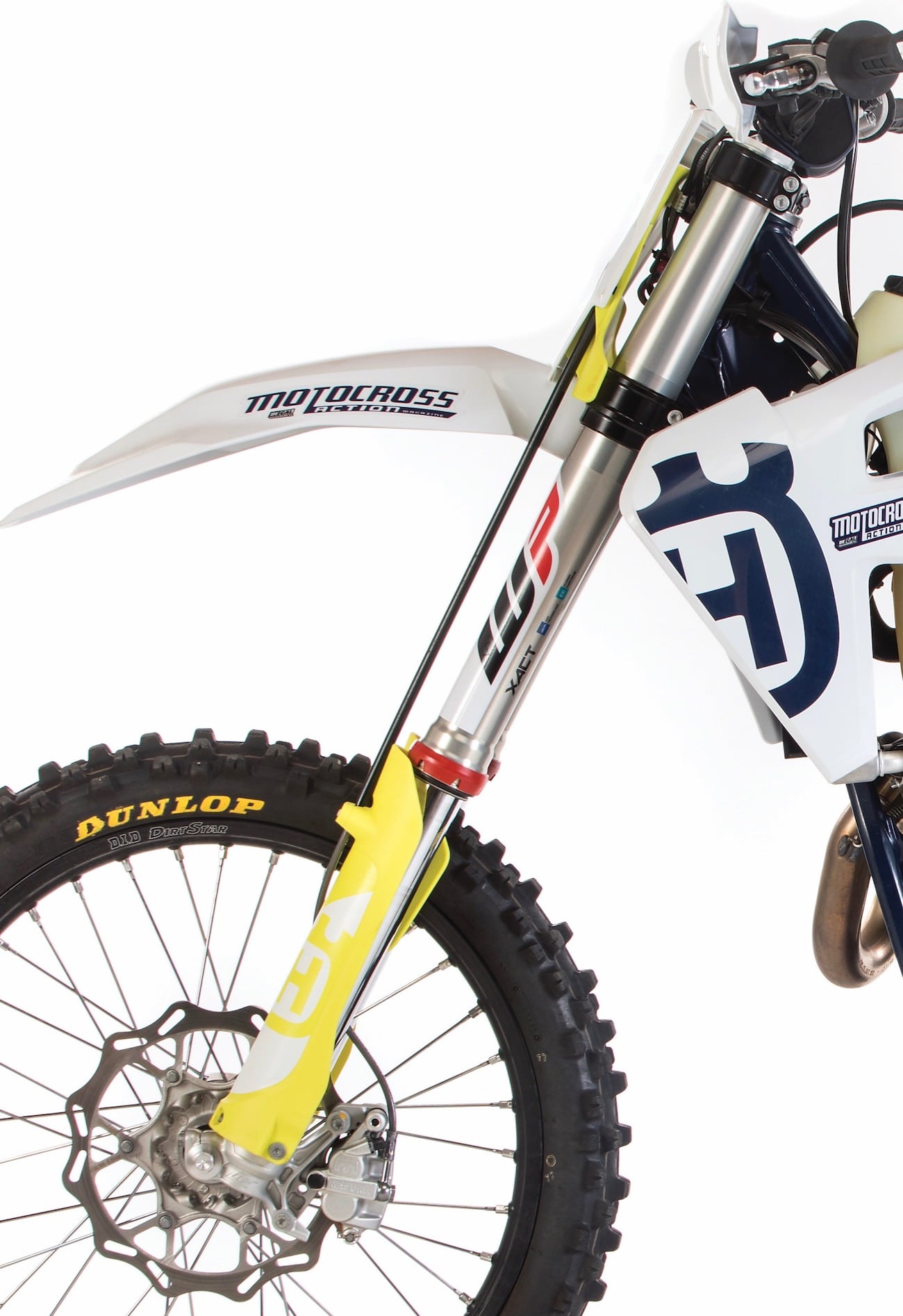
On the FX450, the air fork is a big bonus, because it was easy to make the fork hold up higher and eliminate bottoming by simply raising the air pressure from its stock 146 psi closer to the FC450’s 155 psi setting. As a rule, MXA test riders choose their air pressure based on its ability not to bottom harshly on the track’s biggest G-outs. From there, they concentrate their tuning efforts on the fork’s clickers. A couple clicks in on the fork’s compression clicker make a big difference. Some test riders, but not all, added a small number of rebound clicks to find a good balance between hold up and fork stroke.
We were surprised by the setup of the WP Xact rear shock. Test riders were aware that the damping had been softened up and expected that the compression damping would require some major clickage, but it didn’t. We were puzzled that the compression damping could be lightened, but the shock didn’t feel like a marshmallow. The answer became obvious when we saw the FX450 shock spring was 45 N/mm instead of the 42 N/mm found on the FC450 motocross bike. Since the stiffer shock spring provides a considerable amount of added compression damping, we didn’t need to go crazy with the compression clicker. At the most, some riders added 3 clicks more rebound and 1/4-turn more high-speed compression. If you need more, you will lose the FX450’s off-road ability.
To determine if the 45 N/mm spring is right for you, measure your free sag. If it isn’t between 30mm and 40mm unladened, you need a different spring rate.
 This is how you crank a big berm—although we don’t recommend letting your rear tire go over the top. But, when it does it is spectactular.
This is how you crank a big berm—although we don’t recommend letting your rear tire go over the top. But, when it does it is spectactular.
Q: HOW DOES THE 2020 HUSQVARNA FC450 RUN ON THE RACETRACK?
A: This is, without a doubt, one of the best 450cc engines ever built. Every Pro, Intermediate and Vet racer fell in love with the 2020 Husqvarna FX450 powerband. It delivered what can best be described as “never-ending power.” It was smooth off the bottom, strong through the midrange and continued to pull and pull and pull on top. It makes great power all the way to the rev limiter—and there were lots of times when we would come down a fast straight and realize that we were going way too fast to make the next corner. The power delivery was that deceiving.
It had such a composed power delivery that there were no burps, hiccups or bursts anywhere in the rpm range. It felt slow, but based on the number of riders we passed at the end of straights, it was quasar fast. It felt like we could ride it all day, because it didn’t stretch our arms out of corners or explode with the kind of acceleration that puckers you up. It was fast in a controllable way.
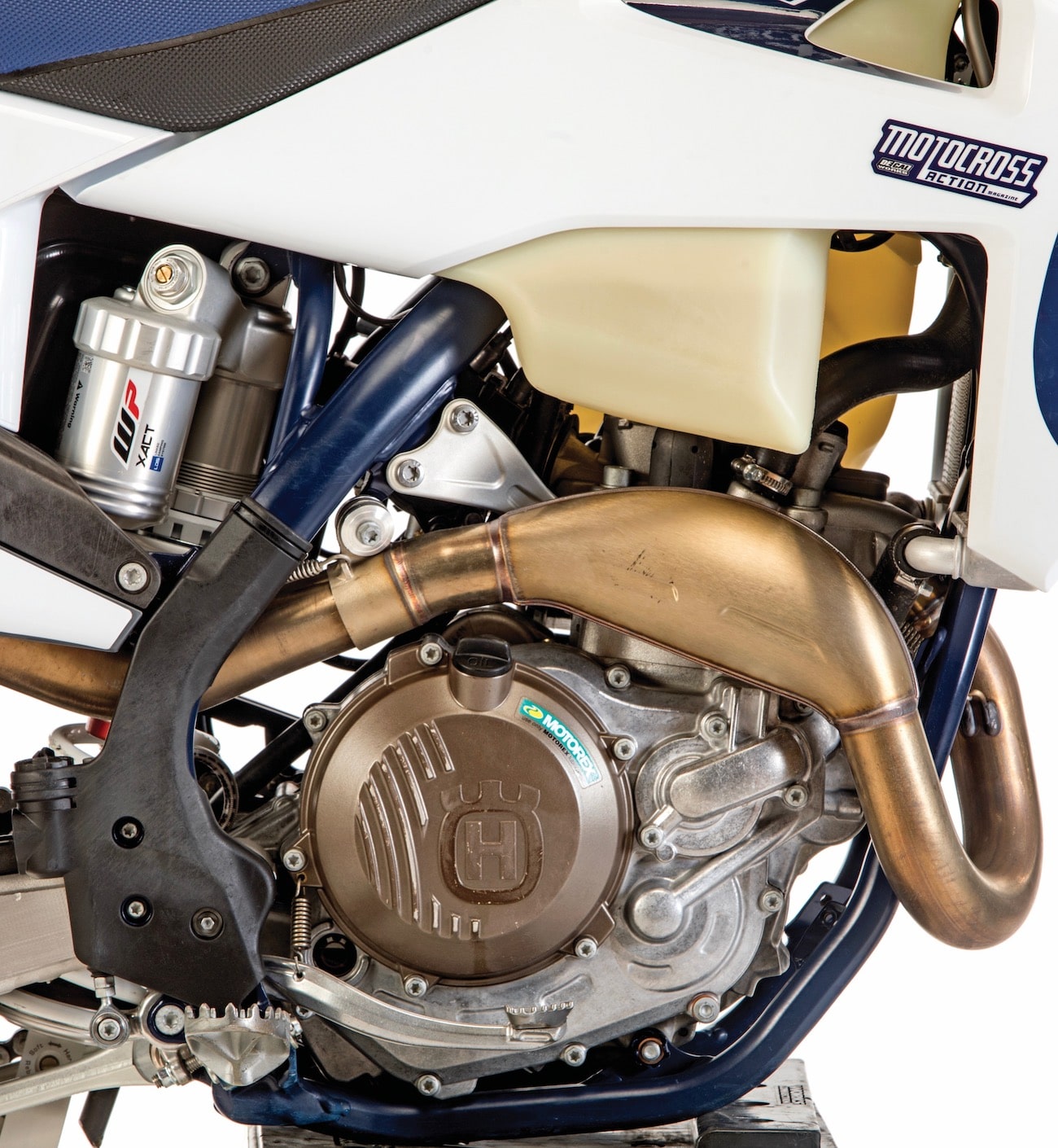 The FX450 power output has almost nothing in common with that of its 2020 Husqvarna FC450 motocross brethren.
The FX450 power output has almost nothing in common with that of its 2020 Husqvarna FC450 motocross brethren.
We know what you are thinking. Way back up at the top of this test we said, “The FX and FC use the same basic engine. That means that the pistons, cams, valves, cranks, cases, 44mm throttle bodies, exhaust systems and cylinder heads are the same on both powerplants.” Now we are saying that the FX450 powerband “has almost nothing in common” with the FC450 engine. How can that be?
The simple answer is mapping. In order to tone down the FX450 engine to make it a little more off-road adept, Husqvarna’s engineers changed the amount of fuel in coordination with ignition timing to iron out the irregular surges of the motocross powerband, creating one seamless river of power. Mapping is the new frontier of tuning for the ought-twenties. Forget about expensive hard parts to make your bike faster; just rely on software.
The benefits of the FX450’s harmonious power delivery didn’t only pay off at the rider’s right wrist, they made the already-sweet Husqvarna frame geometry even more precise at turn-in. The engine’s unruffled composure from low-to-mid-top made the already-good Austrian frame geometry much more sophisticated.
In lots of ways, it reminds the MXA test riders of what Yamaha did to make the 2020 Yamaha YZ450F finally turn in without wiggling, wandering or wagging its head. Yamaha’s solution to a decade of erratic cornering was to mute the power of the 2020 YZ450F down low so that the YZ450F engine churned out a non-confrontational style of power. With less horsepower from off-idle to 9000 rpm, the Yamaha chassis calmed down, held a line and stayed the course until the power came on line after 9 grand. It is the old “slower is faster” strategy. It worked on the 2020 YZ450F’s handling flaws and pays even bigger dividends combined with the FX450’s almost flawless handling.
 We prayed that we would never see the dreaded push-button gas cap ever again. Surprise! It’s back.
We prayed that we would never see the dreaded push-button gas cap ever again. Surprise! It’s back.
Q: IS THE 2020 FX450 A MOTOCROSS BIKE OR AN OFF-ROAD BIKE?
A: Neither. It’s not the ultimate machine to ride in either discipline. Oh, don’t get us wrong; it’s workman-like on a motocross track and more than capable on off-road trails, but there are better bikes for a pure motocross racer and better bikes for a wholehearted off-road rider.
That doesn’t sound like a rousing endorsement of the 2020 Husqvarna FC450, but that’s because this bike isn’t made for the dedicated motocrosser or hardcore off-roader. Nope! It’s made for the all-arounder who is looking for a bike that he can ride in the hills on Saturday and take to the track on Sunday—with very few modifications. For that guy, and Husqvarna believes that there are lots of them, who is looking for one bike that can do more than one thing, this is the ultimate machine.
Q: WHAT DID WE HATE?
A: The hate list:
(1) Bolts. Check the spoke nipples and rear sprocket bolts at very regular intervals.
(2) Blue frame. Would you paint your car that color? Would you paint your house that shade? Would you a want a blue frame that looked old and weathered when it was new?
(3) Compression clicker. We hated the old three-prong compression clicker and don’t like the new two-prong clicker any better. We don’t need more or fewer prongs; we need longer prongs.
(4) Graphics. Kiska, the chief designer for KTM and Husqvarna, was once at the top of its field, but the last couple years of Husky graphics look like they were designed by an intern. The Husky logo is chopped in half, but that might explain why the side number plates are chopped in half also.
(5) Airbox cover. Husky’s airbox cover is so long that when you try to remove it, it fights back. We really had to tug to get it off. Worse yet, when you put the cover back on the bike, you can easily snap the plastic hook that keeps your airbox cover from flapping in the breeze.
(6) Transmission. This bike would be so much better off-road with a six-speed gearbox.
(7) Gearing. Trying to be all things for all types of riding means that the FX450’s five-speed gearing is wrong for both disciplines. We think it should be geared down for off-road (because first gear is too tall) and geared up for motocross (because it has the power to pull taller gears). Gearing it up would allow the racer to stay in second longer and still be able to pull third.
(8) Gas tank. A 2.25-gallon tank is on the cusp of being too small for the new generation of long off-road races—although we like that it is translucent.
(9) Spark arrestor. The FX450 doesn’t come with a USFS-legal spark arrestor—good for motocrossers; not good for woods riders.
(10) Gas cap. There was a time before KTM bought Husqvarna when every KTM dirt bike had the infamous, push-button, quarter-turn gas cap. The MXA test riders hated it, because the push button would stick and stop the rider from putting gas in the bike. Finally, after Roger DeCoster said that he hated the push-button gas cap, KTM replaced it with a thread-on cap. We thought that was the last time we’d ever see the dreaded push-button cap. We were wrong. It comes on the 2020 Husqvarna FX450.
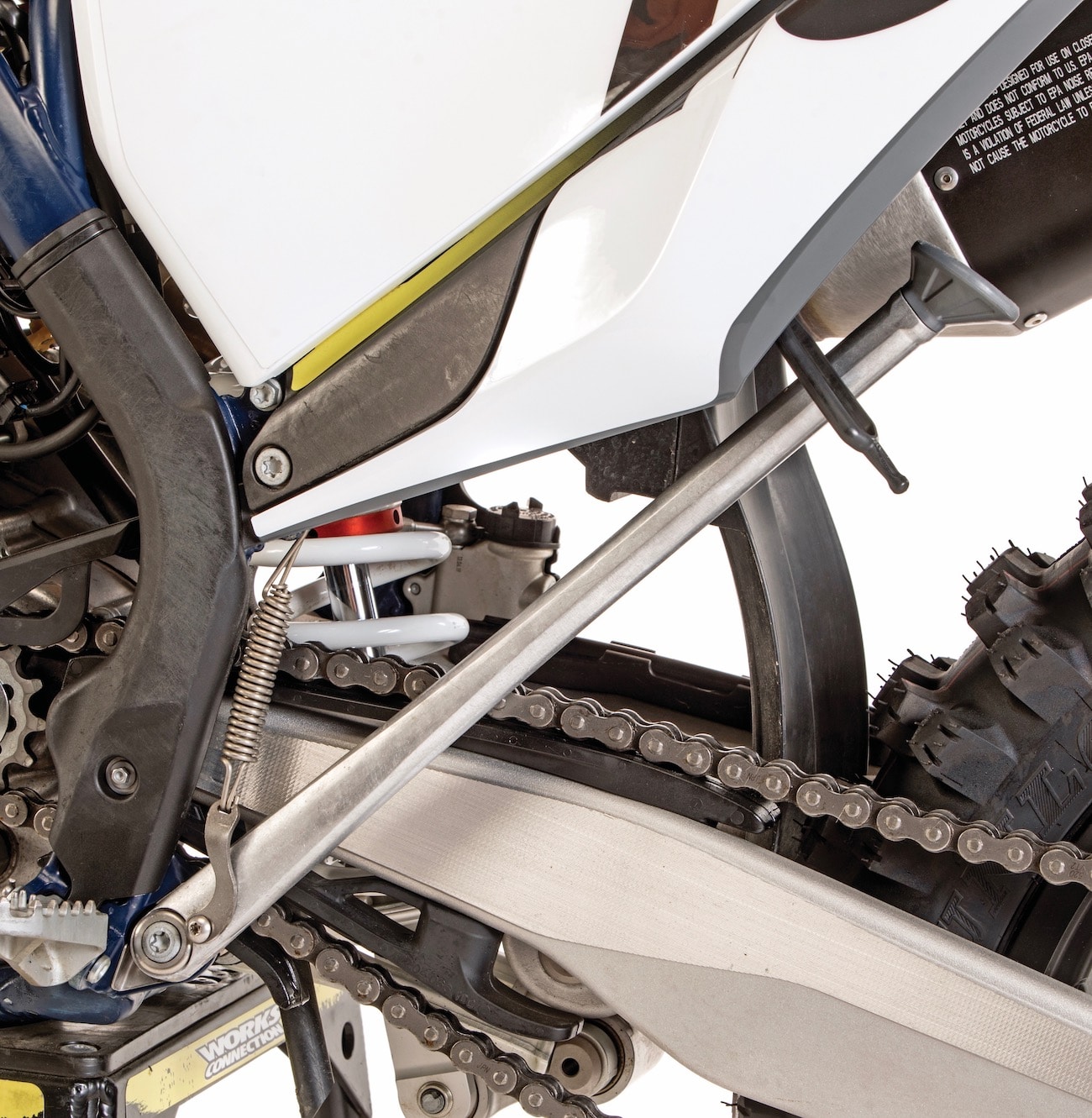 We really liked the kickstand (yes, we are that lazy), but were bummed when they made us take it off for motocross.
We really liked the kickstand (yes, we are that lazy), but were bummed when they made us take it off for motocross.
Q: WHAT DID WE LIKE?
A: The like list:
(1) Magura hydraulic clutch. The FX450 has a Magura hydraulic clutch. The difference between the Magura and Brembo clutch is that the Magura clutch pull feels smooth and linear, while the Brembo has that “pop” feel that tells the rider when the clutch is disengaged
(2) Electronic. The push-button map switch not only has two maps, traction control and launch control on it, it allows you to run traction control with either map to give you more control over when and how the rear tire hooks up.
(3) Powerband. Awesome—in the true meaning of the word. So awesome that we tried the FX450 black box on our FC450.
(4) Lock-on grips. We like the ease of use of Husqvarna’s ODI lock-on grips. They are a little firmer than glue-on grips, but we like the ability to fix a torn grip without having to wait for the glue to dry.
(5) Pankl gearbox. The Husqvarna gearbox is manufactured by Formula 1 transmission supplier Pankl. Enough said.
(6) Fuel gauge. It comes with a “low fuel warning” idiot light. We never knew it was there until we engaged launch control at a race and looked to see if the LC light was flashing—and there was the idiot light, right next to the LC light. The low-fuel warning light is hardly earth-shattering technology on a bike with a translucent gas tank.
(7) Twin Air filter. If you’ve ever installed an air filter into a KTM or Husqvarna, you will be amazed at how foolproof it is compared to the normal gymnastics of other air filter/cage/airbox designs.
Q: WHAT DO WE REALLY THINK?
A: The 2020 Husqvarna FX450 is the ultimate machine for a Renaissance man. Back in the 15th century, if you could paint, sculpt, draw, write and invent, you were called a Renaissance man, which was colloquialized in the 1940s to “jack of all trades.” You can’t be considered a Renaissance man if you only race Supercross. You have to race the outdoor Nationals, sign up for the ISDT, join a Baja 1000 team and build a garage-queen vintage Honda two-stroke. Then, you can be a renaissance man.
And that is who the 2020 Husqvarna FX450 was built for—a man who can, or wants to, do everything on one machine. It is for the Leonardo da Vinci of motorcycle racers.
MXA’S HUSQVARNA FX450 SETUP SPECS
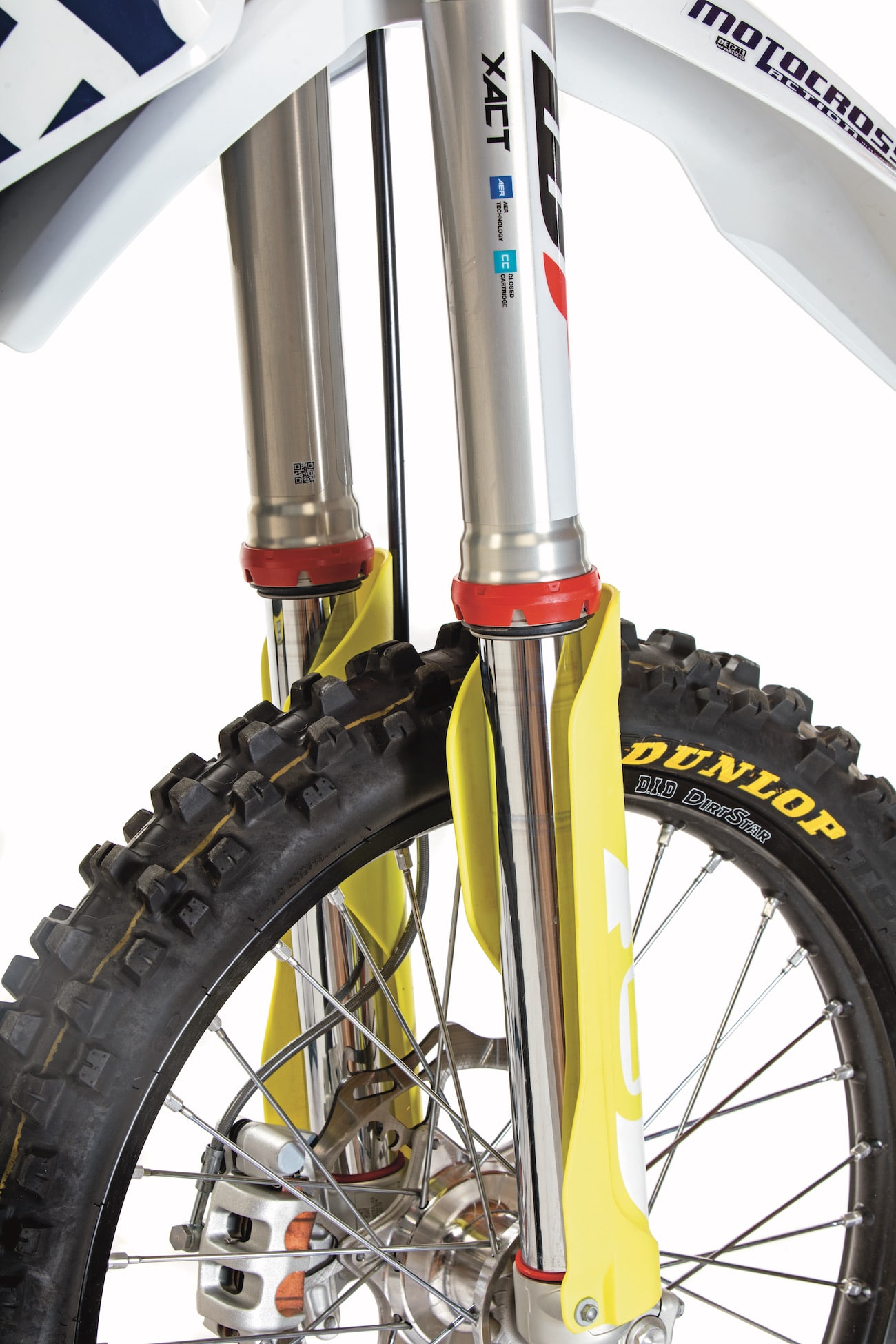 Don’t trust the orange rings as a guide to how much the fork is traveling. After a few hours of use they fall down to the bottom of the forks all by themselves—which makes you think that you are bottoming the forks.
Don’t trust the orange rings as a guide to how much the fork is traveling. After a few hours of use they fall down to the bottom of the forks all by themselves—which makes you think that you are bottoming the forks.
This is how we set up our 2020 Husqvarna FX450 for racing. We offer it as a guide to help you find your own sweet spot.
AER FORK SETTINGS
To manufacture a usable off-road, enduro or cross-country bike, you have to be willing to soften the suspension so that it can work its way through rocks, roots and fallen logs, but, conversely, be able to cover large swaths at high speeds. We think that the 2020 FX450 suspension meets off-road needs better than it does the motocross demands; but, for a guy who wants to use his FX450 on track days, he can find the perfect air pressure, clicker settings and fork height.
For hardcore racing, we recommend this fork setup for an average rider on the 2020 Husqvarna FX450 (stock specs are in parentheses):
Spring rate: 146 psi
Compression: 3-17 clicks (depending on speed)
Rebound: 10 clicks out (12 clicks out stock)
Fork-leg height: Third line
Notes: Pay attention to extreme temperature changes. It doesn’t hurt to reset the air pressure to your chosen settings between motos (once the forks have cooled down from riding). Bleed the outer chambers at regular intervals.
 If you can’t remember the fork settings, there is a sticker on the forks that tell you where to start.
If you can’t remember the fork settings, there is a sticker on the forks that tell you where to start.
WP SHOCK SETTINGS
When it came time to select the spring rate, valving and setup for the off-road FX450, we assumed that it would get lighter valving and a softer-rate shock spring. We were wrong. Husky did lighten the valving but added a stiffer 45 N/mm shock spring. This gives an FX owner more leeway to dial his FX450 shock in for both plonking and jumping. MXA test riders didn’t stray far from the stock 15 clicks out on low-speed compression and 15 clicks out on rebound damping. We used high-speed compression adjusters to have a crossover effect on the whole shock.
For hardcore racing, we recommend this shock setup for the 2020 Husqvarna FC450 (stock specs are in parentheses):
Spring rate: 45 N/mm
Race sag: 105mm
Hi-compression: 1.75 turns out (2 turns out stock)
Lo-compression: 15 clicks out
Rebound: 12 clicks out (15 clicks out stock)
Notes: We turned the high-speed compression damping in 1/4 turn to lessen G-outs and ran more rebound than the recommended setting. Additionally, some test riders ran the race sag at 107mm and slid their forks up 2mm to get the bike down in the corners.



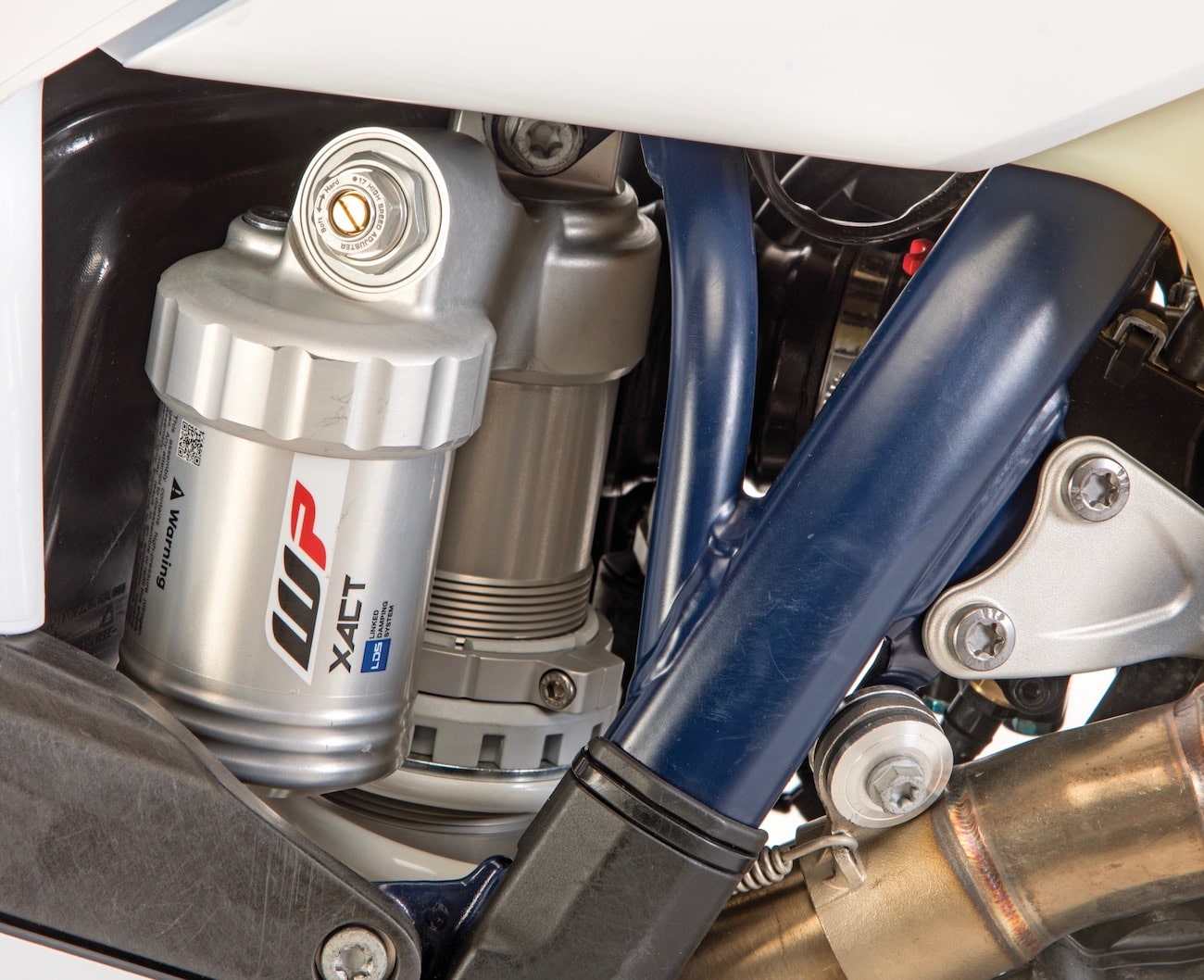






Comments are closed.